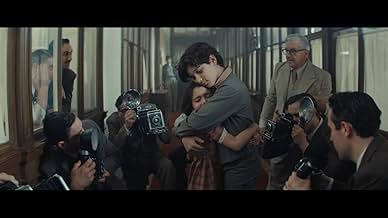Adicionar um enredo no seu idiomaFollows two Neapolitan kids as they journey to New York to escape Italy's early postwar poverty.Follows two Neapolitan kids as they journey to New York to escape Italy's early postwar poverty.Follows two Neapolitan kids as they journey to New York to escape Italy's early postwar poverty.
- Direção
- Roteiristas
- Artistas
- Prêmios
- 2 vitórias e 6 indicações no total
- Direção
- Roteiristas
- Elenco e equipe completos
- Produção, bilheteria e muito mais no IMDbPro
Avaliações em destaque
Io non ho paura (2003) remains a personal favorite, and Gabriele Salvatores is a director I've admired ever since seeing it. In the landscape of Italian cinema, whose glory days seem long past, he remains one of the few names still commanding respect.
The film generated buzz even before its release. This anticipation stemmed from its screenplay, based on a draft co-written by Federico Fellini and Tullio Pinelli-Fellini's longtime collaborator on masterpieces like La Strada (1954) and La Dolce Vita (1960). Dating back to the mid-1940s, the draft was discovered and subsequently published in 2006.
The draft was found by Pinelli himself in a trunk full of odds and ends. Salvatores remarked:
"'To possess a story written by Federico Fellini and Tullio Pinelli, about which almost nothing was known, was in itself a magnificent thing... How could I remain indifferent to something so compelling? It's a story dated to the late 1940s, inspired by a true event, and told like a fable. Moreover, it corresponds to a transitional period in Italian cinema: between neorealism, Italian comedy, and the first experiments with a more fantastical cinema.'"
Although the screenplay is based on a story bearing Fellini's signature, there's little in the film's narrative that could be described as 'Felliniesque'.
While the fact that the story, largely set in New York City's Manhattan, was filmed in Italian studios-making Manhattan look conspicuously like a set-occasionally pulls the viewer out of the reality, Antonio Guerra, playing the protagonist Carmine, manages to win the audience back. 2024 was quite a banner year for young talent; that trend seems poised to continue in 2025.
The sporadic English dialogue interspersed throughout the predominantly Italian film served as a potent reminder of just how beautiful the Italian language is. Because even when spoken by the Italian actors themselves, the English simply sounds coarse following the Italian.
Regrettably, the film also suffers from pacing issues. Roughly divided into three parts-the escape from Italy, the sea voyage, and New York-the film features several anachronistic and jarring details that detract, from the music used in the Manhattan scenes to the inclusion of the 'Women's Liberation' slogan, an emblem that would only emerge two decades after the film's 1940s setting.
Furthermore, the film could easily have been trimmed by about 25 minutes.
Gabriele Salvatores presents us with a Federico Fellini story that might otherwise have been lost to time. Despite its flaws, this undertaking is itself a commendable effort.
The film generated buzz even before its release. This anticipation stemmed from its screenplay, based on a draft co-written by Federico Fellini and Tullio Pinelli-Fellini's longtime collaborator on masterpieces like La Strada (1954) and La Dolce Vita (1960). Dating back to the mid-1940s, the draft was discovered and subsequently published in 2006.
The draft was found by Pinelli himself in a trunk full of odds and ends. Salvatores remarked:
"'To possess a story written by Federico Fellini and Tullio Pinelli, about which almost nothing was known, was in itself a magnificent thing... How could I remain indifferent to something so compelling? It's a story dated to the late 1940s, inspired by a true event, and told like a fable. Moreover, it corresponds to a transitional period in Italian cinema: between neorealism, Italian comedy, and the first experiments with a more fantastical cinema.'"
Although the screenplay is based on a story bearing Fellini's signature, there's little in the film's narrative that could be described as 'Felliniesque'.
While the fact that the story, largely set in New York City's Manhattan, was filmed in Italian studios-making Manhattan look conspicuously like a set-occasionally pulls the viewer out of the reality, Antonio Guerra, playing the protagonist Carmine, manages to win the audience back. 2024 was quite a banner year for young talent; that trend seems poised to continue in 2025.
The sporadic English dialogue interspersed throughout the predominantly Italian film served as a potent reminder of just how beautiful the Italian language is. Because even when spoken by the Italian actors themselves, the English simply sounds coarse following the Italian.
Regrettably, the film also suffers from pacing issues. Roughly divided into three parts-the escape from Italy, the sea voyage, and New York-the film features several anachronistic and jarring details that detract, from the music used in the Manhattan scenes to the inclusion of the 'Women's Liberation' slogan, an emblem that would only emerge two decades after the film's 1940s setting.
Furthermore, the film could easily have been trimmed by about 25 minutes.
Gabriele Salvatores presents us with a Federico Fellini story that might otherwise have been lost to time. Despite its flaws, this undertaking is itself a commendable effort.
I came to see this movie because of the reviews in various digital magazines that talked about the great CGI work they had done to adapt the city of Trieste as a setting to shoot the NY scenes. That's what mainly got my attention.
I'd say the first half is acceptably okay, being a movie 'with kids' (a subgenre that doesn't particularly appeal to me). The first part in Naples, which someone has defined as 'neo-realistic', has its interesting moments, with curious twists that, although it doesn't end up being a great movie, it keeps you sitting in your seat.
The problem begins after an hour of filming, when we see the first scenes of the ship sailing, 'aerial' shots with a CGI design of the 90's and that look like a cheap ad. If there was no budget why put those scenes? They could have avoided them.
But when the movie sinks is in NY. From that moment on, the plot, the dialogues and the construction of the characters fall apart. With one cliché after another, with all the commonplaces of movies about 'Italians in America' reheated without grace or originality. Nothing that happens is believable, neither the Little Italy location, nor the procession (didn't the director and screenwriter see The Godfather II?) nor what the actors do and say. Nothing is saved.
The characters are left without a script, without corporeity, what they say and what they do has neither consistency nor drama (which there should have been). The film, both in its staging and in the construction of characters, becomes a caricature. What a pity!
What happened to them? Precipitation? Lack of budget?
Or did they think that with Fellini's name in the credits and the promise that there is a 'treatment' of this film made by him, as an unrealized project, it would be enough to build a powerful story and the necessary magnitude to be able to stand next to monuments like 'The Godfather' or 'Once Upon a Time in America'?
Just seeing that there are only three reviews I imagine that few people have seen it and even fewer have wanted to comment on it, so I am encouraged to make this review and not recommend this film because for me it has been one of the great disappointments of this year.
The only thing that could be saved is the performance of the two children. I wish them the best.
I'd say the first half is acceptably okay, being a movie 'with kids' (a subgenre that doesn't particularly appeal to me). The first part in Naples, which someone has defined as 'neo-realistic', has its interesting moments, with curious twists that, although it doesn't end up being a great movie, it keeps you sitting in your seat.
The problem begins after an hour of filming, when we see the first scenes of the ship sailing, 'aerial' shots with a CGI design of the 90's and that look like a cheap ad. If there was no budget why put those scenes? They could have avoided them.
But when the movie sinks is in NY. From that moment on, the plot, the dialogues and the construction of the characters fall apart. With one cliché after another, with all the commonplaces of movies about 'Italians in America' reheated without grace or originality. Nothing that happens is believable, neither the Little Italy location, nor the procession (didn't the director and screenwriter see The Godfather II?) nor what the actors do and say. Nothing is saved.
The characters are left without a script, without corporeity, what they say and what they do has neither consistency nor drama (which there should have been). The film, both in its staging and in the construction of characters, becomes a caricature. What a pity!
What happened to them? Precipitation? Lack of budget?
Or did they think that with Fellini's name in the credits and the promise that there is a 'treatment' of this film made by him, as an unrealized project, it would be enough to build a powerful story and the necessary magnitude to be able to stand next to monuments like 'The Godfather' or 'Once Upon a Time in America'?
Just seeing that there are only three reviews I imagine that few people have seen it and even fewer have wanted to comment on it, so I am encouraged to make this review and not recommend this film because for me it has been one of the great disappointments of this year.
The only thing that could be saved is the performance of the two children. I wish them the best.
Gabriele Salvatores' "Naples to New York" is a tender, nostalgic tale that brings an unproduced script by Federico Fellini and Tullio Pinelli to life. Set in the aftermath of World War II, the film follows two Neapolitan children as they embark on a transatlantic journey to New York, seeking escape from the poverty of postwar Italy.
Salvatores pays homage to Fellini's storytelling with a mix of whimsy and melancholy, crafting a narrative that feels both classic and timeless. Pierfrancesco Favino shines as the enigmatic ship captain, guiding the young protagonists with a quiet strength that adds depth to the story. The two child actors deliver heartfelt performances, capturing the innocence and resilience of their characters as they navigate both the physical and emotional turbulence of their journey.
Visually, the film excels with rich, painterly cinematography that evokes the golden age of Italian cinema. The sweeping shots of the ocean and the bustling ship create a sense of grandeur, while the intimate moments ground the story in raw human emotion. The score complements the visuals beautifully, blending traditional Italian melodies with subtle modern touches.
However, *Naples to New York* occasionally struggles to maintain momentum, with certain scenes feeling stretched or overly sentimental. While Salvatores succeeds in honoring Fellini's vision, the film doesn't always escape the shadow of its legendary source material, leaving it feeling more like an homage than a fully realized masterpiece.
This is a film for lovers of classic Italian cinema, rich in atmosphere and emotion. Best enjoyed in a contemplative mood, *Naples to New York* invites viewers to reflect on themes of hope, loss, and the pursuit of a better life.
Rating: 7/10 - A visually stunning tribute to Fellini that tugs at the heartstrings but falls just short of greatness.
Salvatores pays homage to Fellini's storytelling with a mix of whimsy and melancholy, crafting a narrative that feels both classic and timeless. Pierfrancesco Favino shines as the enigmatic ship captain, guiding the young protagonists with a quiet strength that adds depth to the story. The two child actors deliver heartfelt performances, capturing the innocence and resilience of their characters as they navigate both the physical and emotional turbulence of their journey.
Visually, the film excels with rich, painterly cinematography that evokes the golden age of Italian cinema. The sweeping shots of the ocean and the bustling ship create a sense of grandeur, while the intimate moments ground the story in raw human emotion. The score complements the visuals beautifully, blending traditional Italian melodies with subtle modern touches.
However, *Naples to New York* occasionally struggles to maintain momentum, with certain scenes feeling stretched or overly sentimental. While Salvatores succeeds in honoring Fellini's vision, the film doesn't always escape the shadow of its legendary source material, leaving it feeling more like an homage than a fully realized masterpiece.
This is a film for lovers of classic Italian cinema, rich in atmosphere and emotion. Best enjoyed in a contemplative mood, *Naples to New York* invites viewers to reflect on themes of hope, loss, and the pursuit of a better life.
Rating: 7/10 - A visually stunning tribute to Fellini that tugs at the heartstrings but falls just short of greatness.
Gabriele Salvatores has crafted a delightful film based on a treatment written in their youth by Fellini and Pinelli. They are responsible for the story of Celestina, who, a few years after the end of the war, decides to escape a life of hardship in Naples to reach New York, the promised land brimming with opportunities. The protagonist's coming-of-age story is mirrored in the narrative style, which transitions from the neorealism of the first part to the fairy-tale quality of the second. Salvatores and the cast deliver an extraordinary performance, maintaining the film's delicate balance between drama, comedy, and fantasy. The result is a refined elegance that avoids the saccharine or overly sentimental tones the story could have easily inspired. A significant contribution comes from the impeccable production design and the soundtrack, combining period and contemporary music, which imbues the film with a poetic lightness throughout.
Você sabia?
- CuriosidadesFederico Fellini, co-author of the treatment, was the first person Salvatores met at Cinecittà at the beginning of the shoot for his debut film. Fellini was filming And the Ship Sails On and asked Salvatores what his profession was. When Salvatores replied, "director," Fellini placed a hand on his shoulder and said, "Courage!"
- Erros de gravaçãoAlthough the action takes place in 1949, a car FIAT 1100/103 is clearly visible. This model was sold first in 1953.
Principais escolhas
Faça login para avaliar e ver a lista de recomendações personalizadas
- How long is Naples to New York?Fornecido pela Alexa
Detalhes
Bilheteria
- Faturamento bruto mundial
- US$ 4.961.766
- Tempo de duração2 horas 4 minutos
- Cor
- Proporção
- 2.39 : 1
Contribua para esta página
Sugerir uma alteração ou adicionar conteúdo ausente



































